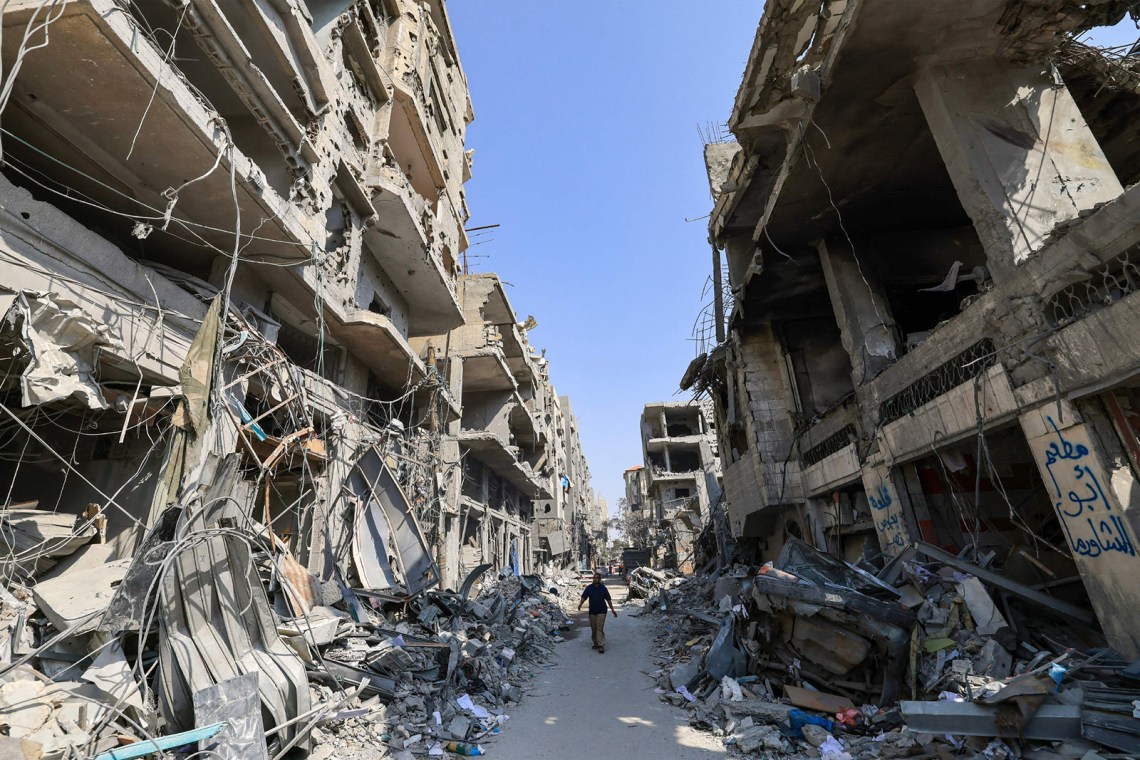We were waiting for the plumbers who had promised to come early on the morning of Saturday, October 7, to our house in Ramallah when the news broke of Hamas’s surprise attack against Israel. When they arrived, they were a team of two. The younger man couldn’t stop watching the video clips Hamas was posting. I could see him smile every time a new one arrived of Palestinian gunmen tearing down the walls and gates that have hemmed in Gaza for the last sixteen years. There’s an inevitable euphoria as the imprisoned anywhere break their chains and escape their incarceration.
The older plumber was more somber. He was fifty-five—a decade and a half younger than me. Like me he has lived through several wars and uprisings. Yet we both agreed that this latest audacious attack was unlike anything we had seen previously. It proved both that no Israeli fortification will keep oppressed Palestinians at bay forever and that Israelis will never be safe as long as they keep 2.3 million human beings locked in an area of 141 square miles and the population of the West Bank confined in unconnected enclaves surrounded by Jewish settlements. The tragedy is that in the absence of any real political opposition, the present right-wing government will heed neither of these obvious conclusions.
All of us living in the occupied territories have been feeling tensions rise over the past six months as settlers undertake continuous criminal attacks against Palestinian civilians in the West Bank. “A total of 1,105 people from 28 communities—about 12% of their population—have been displaced from their places of residence since 2022,” the UN’s Office for the Coordination of Humanitarian Affairs has estimated. Those who fled gave “settler violence and the prevention of access to grazing land by settlers as the primary reason.” The settlers, who as of July held some 2,600 weapons issued by the Israeli army, were no longer restricting their claims to the 62 percent of our land claimed by Israel—called Area C—but were encroaching on areas, such as those adjacent to Nablus, that the Oslo Accords stipulate are under the direct control of the Palestinian National Authority. So much for Israel’s respect for agreements signed with its adversary.
There were other causes for despair. The siege of Gaza, underway since 2007, seemed interminable, and Itamar Ben-Gvir, the minister of national security, had recently worked to reduce the few, hard-won rights of the 4,499 Palestinians in Israeli prisons. On October 18 the Knesset passed a temporary order allowing officials to make them sleep on mattresses on the floor to reduce living space requirements. Palestinian prisoners have also been denied family visits and telephone links with the outside world.
Looming large in the minds of Palestinian Muslims, too, was the slow but persistent effort by fanatic Israelis to carry out their rituals in the Aqsa Mosque in Jerusalem, the third-holiest site in Islam, making us feel that there was nothing sacred left that we could claim as our own. It was this development that gave the Hamas attack its name: “Aqsa Flood.”
Israel was no longer offering Palestinians promises, however flimsy, for future resolution. The peace process was moribund; Israel felt secure in “managing the conflict” and preserving the division between Gaza and the West Bank. The Netanyahu government has made it abundantly clear that Israel claims all of geographic Palestine as its own. In September Netanyahu stood before the UN and announced, in the words of a subsequent press release, that “Israel can become a bridge of peace and prosperity, paving the way for a new Middle East.” He showed a map of the region in which Palestine was obliterated. “We must not,” he said, “give the Palestinian State a veto against a peace process.”
Israelis should have known that violence will erupt when people have no hope and no other options. It was to Hamas’s advantage that the Israeli government arrogantly dismissed the possibility that acting as supreme masters over the Palestinians could engender such a reaction.
It’s likely that Netanyahu had been hoping for a war. Indeed this one has so far temporarily saved him from the protests that have swept Israel in recent months, and on October 12 he formed an emergency unity government that included his center-right rival, the former IDF general Benny Gantz. Yet Netanyahu is likely well aware that this reprieve will be short-lived. An attack on this scale under his watch should have occasioned his immediate resignation, but as long as the war against Gaza continues he and his defense minister, Yoav Gallant, will not only remain in office but have expanded powers. Perhaps by escalating the severity of the reprisals against Gaza he is trying to win himself more time.
Palestinians, whether in Gaza or the West Bank, had good reason on October 7 to worry that in the hands of these extremists greater tragedies could be expected than in the past. “The enemy will pay an unprecedented price,” Netanyahu said that day. “We are at war and will win.” Later he threatened to turn Gaza into a “deserted island.”
Advertisement
Those fears have come to pass. The human suffering that the people of Gaza have endured since October 7 is beyond comprehension. On Monday, October 9, Gallant announced that Israel would impose a “complete siege” on the enclave: “There will be no electricity, no food, no fuel, everything is closed.” As a consequence of this policy, Gaza’s health care system is at the time of this writing “facing collapse,” as Doctors Without Borders has said, its hospitals “overwhelmed and lacking resources.” On October 21 the Guardian reported that, according to doctors in the enclave, 130 premature babies were in “imminent danger due to a lack of fuel.”
More than a million people in Gaza have already been displaced, many of them having fled after Israel ordered the entire northern population to evacuate. In its persistent attempt to prove to the local population that nowhere in the north of Gaza is safe, on October 19 Israel bombed a Greek Orthodox church compound where at least five hundred Muslims and Christians had taken shelter, killing eighteen people. Seeing a photo of the tent camp in the southern Gazan city of Khan Yunis newly built to house the refugees from the north, I thought of the images of Palestinians who ended up in similar camps after they were forced out of their homes in 1948.
A resident of the north named Lubna was among those forced to move south to Khan Yunis—which has itself in recent days been the target of repeated bombing. According to two Guardian reporters,
alongside the bombing, the worst privation for her family is the lack of water. Gaza has been cut off from fuel supplies for two weeks now, so there is no power to run its desalination plants or water pumps. Even if more relief convoys get through from Egypt, Israel has prohibited them from bringing fuel, lest it be used by Hamas.
Each person gets under a liter a day, Lubna told them—significantly less than what the UN deems the “bare minimum for basic survival.”
By October 26 twenty-seven journalists had been killed since the start of the war, according to the Committee to Protect Journalists: four Israeli reporters, a Reuters video journalist killed in southern Lebanon (by a shell fired from across the Israeli border), and twenty-two Palestinian journalists in Gaza. One of the few reporters left in Gaza is Jamileh Tawfiq, who like Lubna had to move to Khan Yunis from her home in the north. She told the Guardian that she was staying in an overcrowded, unhygienic UN compound. “No one knows what is going to happen next,” she said:
It feels as if they are trying to control our fates; they even made us leave our homes, not knowing if we can ever return. We’re trying to stay alive, but we don’t have hope any more. We are destroyed from the inside, and even if this ends, I don’t think life will ever be normal again.
The uncertainty, with no prospect for an end to the war anytime soon, must be torturous.
During his visit on October 18 President Joe Biden urged Israel to allow humanitarian aid into Gaza. “Like the United States, you don’t live by the rules of terrorists,” he told Israeli leaders. “You live by the rule of law.” After lengthy negotiations with Israel, on October 21 Egypt started allowing up to twenty trucks a day to bring medical supplies and other aid through the Rafah border crossing—only a small sliver of the relief that Gaza’s population needs. Before the war about five hundred trucks supplied the enclave each day.
Missing from the shipment was “the fuel needed to power hospitals, keep ambulances moving, or to pump water from the ground,” a spokesperson for the NGO ActionAid told another Guardian reporter:
We’re hearing stories every day of communities coming together to donate whatever fuel they have remaining to keep incubators going for newborns who are in a critical condition…. We’re urgently calling for a ceasefire and for the opening of humanitarian corridors.
But Israel’s army will surely find a way to proceed with killing thousands more fighters and civilians. Already the death toll from its bombardment of Gaza far exceeds that of its previous full-scale war with Gaza nine years ago.
Palestinian civilians in the West Bank have not been spared violent reprisal. In a twelve-mile stretch east of Ramallah, heavily armed settlers have been forcing communities of Palestinian Bedouins to flee entire villages en masse—what the humanitarian coordinator for the Israeli human rights group Yesh Din has called “a silent annexation.” On October 20 Al Jazeera reported that “with checkpoints closed and roads too dangerous to pass,” Palestinian villages in Area C found themselves cut off from humanitarian groups. “They have no protection at all,” a spokesperson for the human rights organization B’Tselem told the network. This has made the settlers more brazen. A video from B’Tselem shows a settler entering the village of At-Tuwani in the South Hebron Hills, approaching a Palestinian man, and shooting him at point-blank range as Israeli soldiers look on.
Advertisement
Wars are usually harbingers of change. Yet this region’s previous wars have achieved no fundamental progress toward peace. Israel has continued to claim that it has no partner for peace and has not cultivated one. Mahmoud Abbas, the head of the Palestinian National Authority, who has consistently opposed armed resistance and repeatedly called for a negotiated settlement, was recently belittled by a senior Israeli official close to Netanyahu as the “mayor of Ramallah.”
There is something self-deceiving about Israel’s determination to pursue only revenge against Hamas rather than peace with the Palestinians. For it will never be possible to destroy the Palestinians or force them to leave. The surrounding countries have taken firm positions against admitting Palestinian refugees: Egypt has so far refused to let residents of Gaza leave through the Rafah crossing, the only way into and out of Gaza that falls outside Israel’s control, while Jordan’s King Abdullah has insisted that there must be “no refugees in Jordan and no refugees in Egypt.”
But whether or not the borders open, Palestinians themselves have been determined not to let Israel engineer a second Nakba by ethnically cleansing them from Gaza. So far the Israeli army has had only mixed success in forcing the enclave’s northern population to move south. At least 700,000 people have fled to southern Gaza, but roughly 350,000 remain in Gaza City. It should be clear to Israelis that we are here to stay, and as my father, the lawyer Aziz Shehadeh, concluded after a life of working for peace, the only real victory is when we have mutual recognition and self-determination.
—October 26, 2023
This Issue
November 23, 2023
Inhumane Times
Ed Ruscha Bigger than Actual Size




